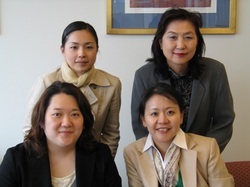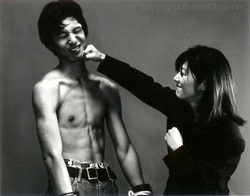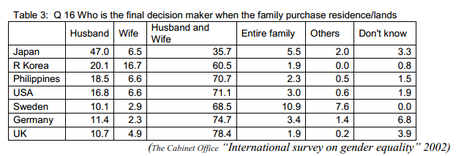There are many issues that threatened cultural diversity from biodiversity in the world today. Today in the world 50 percent of species of different cultures that once existed are gone. This is not from change because cultures are contastly changing or from technology, what to blame is power. Different countries and cultures want to gain power to they go around and drive out other cultures from their land. Deforestation in Southeast Asia was to blame for driving out the Panam people who lived in the forest until about 10 years ago but now most of their people were turned to prostitution. Another problem would be disease that drove the people out of their land. Language loss can be to blame for these cultures to be lost. At one point in time there were 6000 different languages people spoke, but nearly half now arent being taught which is realistically making them exstint, if nobody can speak that language anymore, how is it going to be possible for generations next to learn the language.
Personally I dont think its necessary for the government to step in and protect these cultures to make sure they live on longer. Its a natural thing for things to just fall out and be extinct. Though, it would be helpful for the government to enforce rules to make sure other cultures cant invade the others land but its like natual selection, the people who are the best fit for the land can take it. And if the government did step in how would they make sure these cultures would live on, would they make these children learn the language from their ancesters? I dont think that its a realistic goal to have the government help these cultures.
I feel like Japan is one of the more globalized countries next to us, Untied States. They export an abundance of high tech electronics, cars, etc. which gives the country much revenue because they are selling all these products around the world to other countries. Though, with making all these expensive products they can find themselves in a massive amount of debt. Their debt right now is approximately 11,196,021,600,000, but it is always rising each second. This debt can have to do with all the products they made that may not have been so successful and of course the wars they’ve been in have a lot to do with that. There is not just one reason why they have acquired so much debt, they are many reasons why so we can’t point out fingers at any one specific to blame for Japan’s debt. All the exports that Japan produces are both a help and hinder to the country. It helps by selling those products to other countries to make money, but also making these products is quite expensive. Japan has people that make it, they price of the parts, everything adds up. Though, making high tech gadgets makes them more advanced than other countries which can put them up to par with the United States and which is always a good thing for them. Globalization has helped women in Japan in numerous ways as well. Women are being taken more seriously in the workforce from their fellow co-workers. They do have a long way still, these women that do get hired are usually the office women, and coffee maker, you rarely see a women climbing the corporate ladder when in Japan, though it does happen don’t get me wrong, it’s just not usual. Also not only women are taken more seriously in the work place, they have more rights of their own such as not having to marry at such an early age, they have more freedom and independence from their family which used to force them to do things such as early marriage or arranged marriages. It seems like globalization has helped the women the most for the better. It doesn’t seem like men have gained anything from globalization, it actually seemed like they lost some of their power, because they used to be in charge of everything and now women have taken over some of that power now, such as men arent the only ones that can decide if they want a divorce, women can deicde that too, and men used to be the only one to be able to owm property but now women can own some as well.
 In the 1950's women were surveyed and asked if they had the chance to be reborn would they want to be a women and only 16.1 percent agreed, which is not a lot at all, by 1987 that percentage had doubled to about 53.7 (Nakamura,1996). The status of women in gradually improving not only in the workplace but also in the family and how society views them. Though, its improving faster in the household more than than the workplace and society. "A man's place is at work, while a woman's place is in the home," is starting to fade away. Now it seems like a woman's place is at work AND in the home. Women started working in factories which aren't the best and safest place to be working at. in the 1990's about 50 percent of females over the age of 15 were working in paid labor force. As you can see in the graph below more and more females are becoming managers, chiefs, and directors in the last 30 years. The life expectancy also rose to about 82.98, while men are at about 76.57 in 1994(Nakamura,1996).. Also women are starting to have the freedom of not having to get married at such a young age anymore, the "proper" age to get married is starting to vanish in Japan, which also makes the number of women that are unmarried to increase(Lim Shan-Loong,NA). Getting married at such a young age isn't pushed on the women as much as it was lets say 20 or 30 years ago. About 40 percent of women in the 20's are not married. The education rate for females is also rising, more and more females are found at four year universities and junior colleges(Lim Shan-Loong,2000). Though, for some reason the parents of females urge their daughters to go to junior colleges rather than a four year.(Nakamura,1996). Woman surpassed males on voting too, in about the 1990's is when this changed occurred. Females became more interested in politics right about after the the war, 40 percent of females said they "have an interest". and 60 percent don't, but those number reversed in the 1990's. As you can see in the graphs below the statement "men at work and women at home", people are agreeing less and less with it as the years go on. In 1992 232 percent of people agreed with this but when it came to 2007 13.8 percent agreed with that statement, so you can see the change in the way people are thinking(Nakamura,1996). But as you can see in the other statement, "Who makes the final decision in the household" the husband seems to take charge of the decisions even though, people agree with the wife being at home, you would think they would have the household decisions, but clearly the husband takes the authority over the home still. Nakamura M. (1996, Feb 26). The present status of women. Retrieved from http://www.gender.go.jp/english_contents/category/pub/whitepaper/plan2000/e01.html
Friedman , S. (1992). The changing roles of women in japan. Retrieved from http://www2.gol.com/users/friedman/writings/p1.html Lim Shan-Loon, M. (2000, March 14). Gender roles in japan. Retrieved from http://marklsl.tripod.com/Writings/japan.htm
 Gender Roles in Japan
In Japan, women and men have very different culture between the two of each other, just like any other country in the world. Though, as the years go on you can see changes in how the men and the women of Japan are looked at by other citizens there.
In about the 12th century women were allowed to inherit and own property of their own, but that right was later taken away in the 1603-1868 A.D. and made it to the men of the family were the only ones to obtain property(Kumar,2011). It seemed like back then in those days the families and women with the higher social rank were more restricted to these were as opposed to the peasants which the women were more independent and didn’t necessarily have to abide to those rules. Men were in charge of the household and what he says goes. They were looked up to from the family as superior.
In the early 18th century women started being placed in the workforce because of the turn to industrialization Japan took(Gurtov,1998). Though since they began to have the opportunity to work, the conditions that they had to face were very unhealthy and not safe for them, they were paid unfairly with the men getting higher wages than the women and their independence within the community was still very limited.
In the 1920’s-30’s women were looked at just “baby makers” you could say. There was a rise in Japanese nationalism, which meant they needed more soldiers for the country so the slogan "UMEYO! FUYASEYO!", which means “give birth and multiply” was brought around(Kumar,2011). The government was happy that the women can do this more them and applauded them for it. While this baby boom was going on women were still looking for more ways they can obtain more rights for themselves by campaigning.
After the war Japan wrote a new constitutuion, which gave the men and women equal rights on property and voting. They also got the right to divorce their spouse and be able to take the custody of their children, which they weren’t allowed to until then. Though, these women were allowed to be apart of the workforce they were still had the responsibility of taking care of all the housework and taking care of the children so many of the women stopped working until all their children was in school and taken care of when they had the chance to work(Gurtov, 2011).
In today’s society men are looked at as he is the bread winner of the family, working all day and performing approx. 30 minutes of house work and the women are expected to take care of the children and the housework that needs to be done(Smith, 2008). Though, now men and women have equal rights, its still how it was 60 years ago, with a little alteration. You can see more women today in politics and in universities getting their degree of their dreams. Also more women are working in companies and factories. It’s not uncommon to see these Japanese women succeeding in their country which is a great thing!
Citations:
Gurtov, D. (4, April 2011). Transformation of female gender roles in japan. Retrieved from http://davegurtov.hubpages.com/hub/JapaneseFemaleGenderRoles
KUMAR , V. (26, June 2011). Japanese views on gender. Retrieved from http://expertscolumn.com/content/japanese-views-gender-roles
Smith, J. (2008, April 21). Japanese views on gender 2. Retrieved from http://www.helium.com/items/1009837-japanese-views-on-gender-roles
Friedman , S. (1992, December). The changing roles of women in japan. Retrieved from http://www2.gol.com/users/friedman/writings/p1.html
|




 RSS Feed
RSS Feed